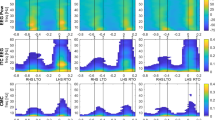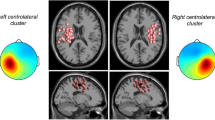Abstract
Background
The ability to maintain adequate motor-cognitive performance under increasing task demands depends on the regulation and coordination of neural resources. Studies have shown that such resources diminish with aging and disease. EEG spectral analysis is a method that has the potential to provide insight into neural alterations affecting motor-cognitive performance. The aim of this study was to assess changes in spectral analysis during dual-task walking in aging and disease
Methods
10 young adults, ten older adults, and ten patients with Parkinson’s disease (PD) completed an auditory oddball task while standing and while walking on a treadmill. Spectral power within four frequency bandwidths, delta (< 4 Hz), theta (4–8 Hz), alpha (8–12 Hz), and beta (12–30 Hz), was calculated using Event-Related Spectral Perturbation (ERSP) analyses and compared between single task and dual task and between groups.
Results
Differences in ERSP were found in all groups between the single and dual-task conditions. In response to dual-task walking, beta increased in all groups (p < 0.026), delta decreased in young adults (p = 0.03) and patients with PD (0.015) while theta increased in young adults (p = 0.028) but decreased in older adults (p = 0.02) and patients with PD (p = 0.015). Differences were seen between the young, the older adults, and the patients with PD.
Conclusions
These findings are the first to show changes in the power of different frequency bands during dual-task walking with aging and disease. These specific brain modulations may reflect deficits in readiness and allocation of attention that may be responsible for the deficits in dual-task performance.



Similar content being viewed by others
Code availability
Not applicable.
References
Hausdorff JM (2007) Gait dynamics, fractals and falls: finding meaning in the stride-to-stride fluctuations of human walking. Hum Mov Sci 26:555–589
Kobsar D, Olson C, Paranjape R, Hadjistavropoulos T, Barden JM (2014) Evaluation of age-related differences in the stride-to-stride fluctuations, regularity and symmetry of gait using a waist-mounted tri-axial accelerometer. Gait Posture 39:553–557
Moon Y, Sung J, An R, Hernandez ME, Sosnoff JJ (2016) Gait variability in people with neurological disorders: a systematic review and meta-analysis. Hum Mov Sci 47:197–208
Hausdorff JM (2009) Gait dynamics in Parkinson’s disease: common and distinct behavior among stride length, gait variability, and fractal-like scaling. Chaos 19:026113
Marmelat V, Reynolds NR, Hellman A (2018) Gait dynamics in Parkinson's disease: short gait trials “stitched” together provide different fractal fluctuations compared to longer trials. Front Physiol 9:861
Montero-Odasso M, Verghese J, Beauchet O, Hausdorff JM (2012) Gait and cognition: a complementary approach to understanding brain function and the risk of falling. J Am Geriatr Soc 60:2127–2136
Morley JE (2016) Gait, falls, and dementia. J Am Med Dir Assoc. 17:467–470
Yogev-Seligmann G, Hausdorff JM, Giladi N (2008) The role of executive function and attention in gait. Mov Disord 23:329–342
Berka C, Levendowski DJ, Lumicao MN, Yau A, Davis G, Zivkovic VT, Olmstead RE, Tremoulet PD, Craven PL (2007) EEG correlates of task engagement and mental workload in vigilance, learning, and memory tasks. Aviat Space Environ Med 78:B231–B244
Rietschel JC, McDonald CG, Goodman RN, Miller MW, Jones-Lush LM, Wittenberg GF, Hatfield BD (2014) Psychophysiological support of increasing attentional reserve during the development of a motor skill. Biol Psychol 103:349–356
Polich J (2004) Clinical application of the P300 event-related brain potential. Phys Med Rehabil Clin N Am 15:133–161
Burns CG, Fairclough SH (2015) Use of auditory event-related potentials to measure immersion during a computer game. Int J Hum-Comput Stud 73:107–114
Polich J (2007) Updating P300: an integrative theory of P3a and P3b. Clin Neurophysiol 118:2128–2148
Antal A, Dibo G, Keri S, Gabor K, Janka Z, Vecsei L, Benedek G (2000) P300 component of visual event-related potentials distinguishes patients with idiopathic Parkinson’s disease from patients with essential tremor. J Neural Transm (Vienna ) 107:787–797
Solis-Vivanco R, Rodriguez-Violante M, Rodriguez-Agudelo Y, Schilmann A, Rodriguez-Ortiz U, Ricardo-Garcell J (2015) The P3a wave: a reliable neurophysiological measure of Parkinson’s disease duration and severity. Clin Neurophysiol 126:2142–2149
Seer C, Lange F, Georgiev D, Jahanshahi M, Kopp B (2016) Event-related potentials and cognition in Parkinson’s disease: an integrative review. Neurosci Biobehav Rev 71:691–714
Munte TF, Joppich G, Dauper J, Schrader C, Dengler R, Heldmann M (2015) Random number generation and executive functions in Parkinson's disease: an event-related brain potential study. J Parkinsons Dis 5:613–620
Pauletti C, Mannarelli D, Locuratolo N, Curra A, Marinelli L, Fattapposta F (2019) Central fatigue and attentional processing in Parkinson’s disease: an event-related potentials study. Clin Neurophysiol 130:692–700
Beurskens R, Steinberg F, Antoniewicz F, Wolff W, Granacher U (2016) Neural correlates of dual-task walking: effects of cognitive versus motor interference in young adults. Neural Plast 2016:8032180
Bradford JC, Lukos JR, Passaro A, Ries A, Ferris DP (2019) Effects of locomotor demands on cognitive processing. Sci Rep 9(1):1–12
De SP, Butler JS, Malcolm BR, Foxe JJ (2014) Recalibration of inhibitory control systems during walking-related dual-task interference: a mobile brain-body imaging (MOBI) study. Neuroimage 94:55–64
Maidan I, Fahoum F, Shustak S, Gazit E, Patashov D, Tchertov D, Giladi N, Hausdorff JM, Mirelman A (2019) Changes in event-related potentials during dual task walking in aging and Parkinson’s disease. Clin Neurophysiol 130:224–230
Malcolm BR, Foxe JJ, Butler JS, De SP (2015) The aging brain shows less flexible reallocation of cognitive resources during dual-task walking: a mobile brain/body imaging (MoBI) study. Neuroimage 117:230–242
Shaw EP, Rietschel JC, Hendershot BD, Pruziner AL, Miller MW, Hatfield BD, Gentili RJ (2018) Measurement of attentional reserve and mental effort for cognitive workload assessment under various task demands during dual-task walking. Biol Psychol 134:39–51
Nasreddine ZS, Phillips NA, Bedirian V, Charbonneau S, Whitehead V, Collin I, Cummings JL, Chertkow H (2005) The Montreal Cognitive Assessment, MoCA: a brief screening tool for mild cognitive impairment. J Am Geriatr Soc 53:695–699
Rosenblum Y, Maidan I, Fahoum F, Giladi N, Bergman N, Shiner T, Mirelman A (2020) Differential changes in visual and auditory event-related oscillations in dementia with Lewy bodies. Clin Neurophysiol. https://doi.org/10.1016/j.clinph.2020.06.029
Goetz CG, Tilley BC, Shaftman SR, Stebbins GT, Fahn S, Martinez-Martin P, Poewe W, Sampaio C, Stern MB, Dodel R, Dubois B, Holloway R, Jankovic J, Kulisevsky J, Lang AE, Lees A, Leurgans S, LeWitt PA, Nyenhuis D, Olanow CW, Rascol O, Schrag A, Teresi JA, van Hilten JJ, LaPelle N (2008) Movement disorder society-sponsored revision of the unified Parkinson’s disease rating scale (MDS-UPDRS): scale presentation and clinimetric testing results. Mov Disord 23:2129–2170
Delorme A, Makeig S (2004) EEGLAB: an open source toolbox for analysis of single-trial EEG dynamics including independent component analysis. J Neurosci Methods 134:9–21
Gramann K, Gwin JT, Bigdely-Shamlo N, Ferris DP, Makeig S (2010) Visual evoked responses during standing and walking. Front Hum Neurosci 4:202
Maris E, Oostenveld R (2007) Nonparametric statistical testing of EEG- and MEG-data. J Neurosci Methods 164:177–190
Basar-Eroglu C, Basar E, Demiralp T, Schurmann M (1992) P300-response: possible psychophysiological correlates in delta and theta frequency channels. A review. Int J Psychophysiol 13:161–179
Basar E (2006) The theory of the whole-brain-work. Int J Psychophysiol 60:133–138
Picton TW (1992) The P300 wave of the human event-related potential. J Clin Neurophysiol 9:456–479
Buzsבki G (2006) Rhythms of the brain. Oxford University Press, New York
Basar-Eroglu C, Demiralp T, Schurmann M, Basar E (2001) Topological distribution of oddball ‘P300’ responses. Int J Psychophysiol 39:213–220
Basar E, Basar-Eroglu C, Karakas S, Schurmann M (1999) Are cognitive processes manifested in event-related gamma, alpha, theta and delta oscillations in the EEG? Neurosci Lett 259:165–168
Gola M, Kaminski J, Brzezicka A, Wrobel A (2012) beta band oscillations as a correlate of alertness–changes in aging. Int J Psychophysiol 85:62–67
Kline JE, Poggensee K, Ferris DP (2014) Your brain on speed: cognitive performance of a spatial working memory task is not affected by walking speed. Front Hum Neurosci 8:288
Acknowledgements
We thank the research participants and the research assistants for their time and effort.
Funding
No funding was received.
Author information
Authors and Affiliations
Contributions
IM, FF, JH, NG, and AM contributed to the concept and rationale for the study. DP, RS and IM contributed to data analysis. DP, FF, RS, AM, and IM contributed to the interpretation of the results and to the drafting of the manuscript. All authors participated in the approval of the final manuscript and take responsibility for the content and interpretation of this article.
Corresponding author
Ethics declarations
Conflicts of interest
The authors have no conflicts of interest to declare.
Ethics approval
The study was approved by local ethical committee and was performed according to the principles of the Declaration of Helsinki.
Consent to participate
All participants gave their informed written consent prior to participation.
Consent for publication
Not applicable.
Rights and permissions
About this article
Cite this article
Possti, D., Fahoum, F., Sosnik, R. et al. Changes in the EEG spectral power during dual-task walking with aging and Parkinson’s disease: initial findings using Event-Related Spectral Perturbation analysis. J Neurol 268, 161–168 (2021). https://doi.org/10.1007/s00415-020-10104-1
Received:
Revised:
Accepted:
Published:
Issue Date:
DOI: https://doi.org/10.1007/s00415-020-10104-1




